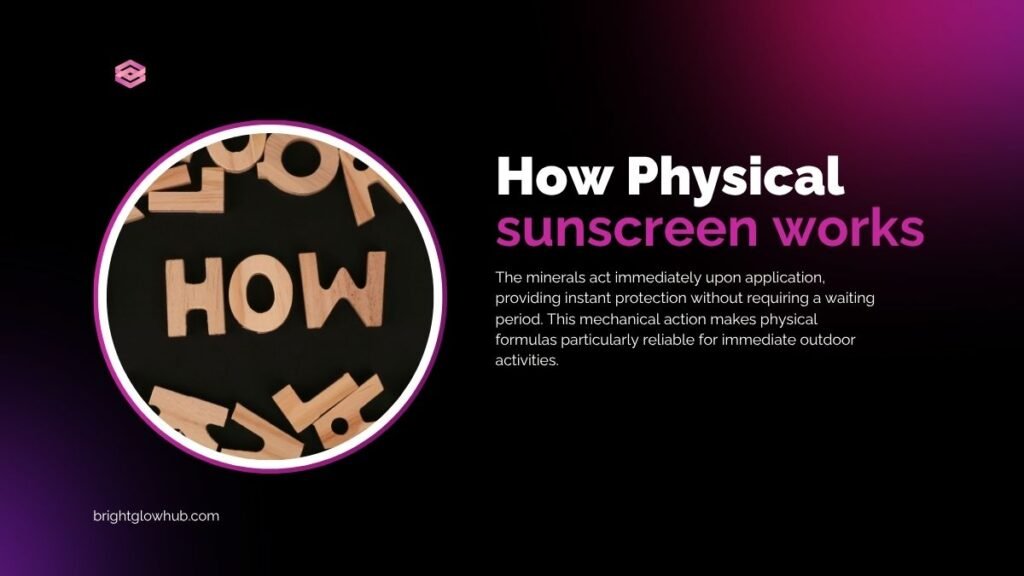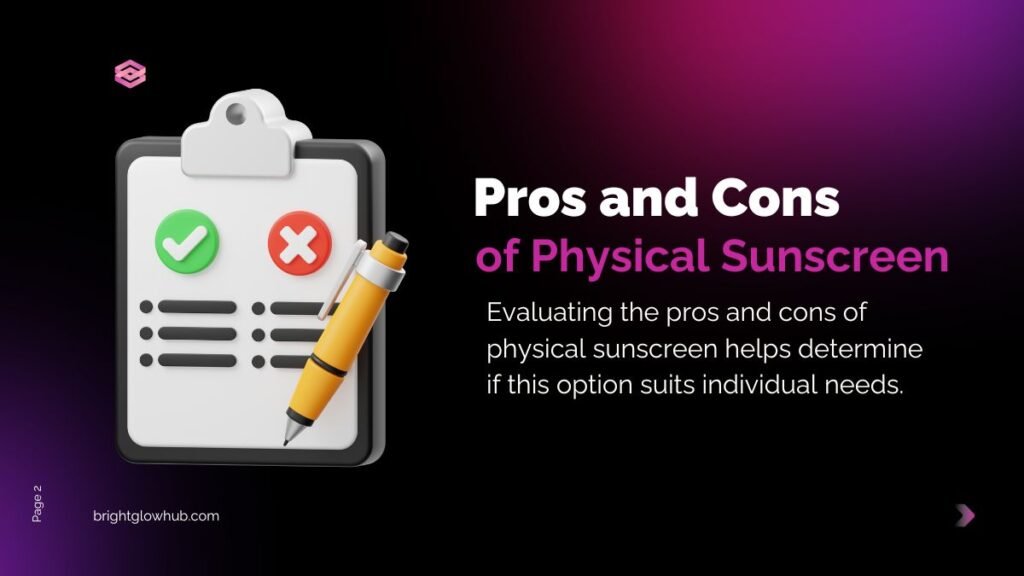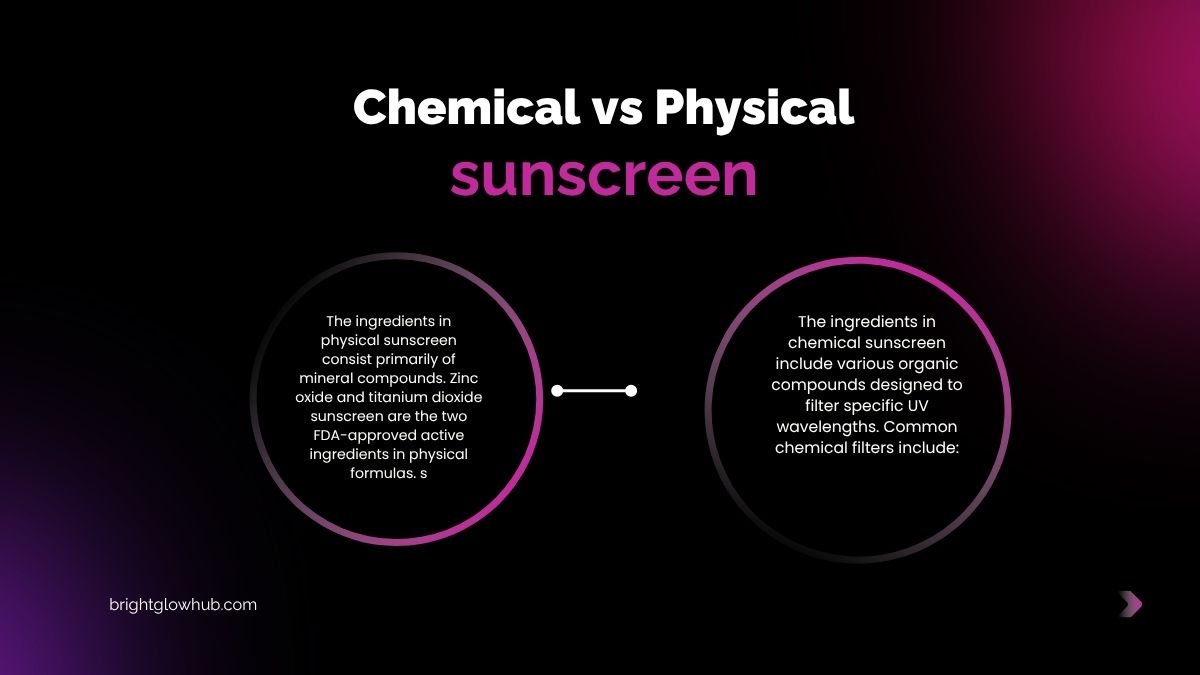Table of Contents
Choosing the right sun protection can feel overwhelming with so many options available. Understanding the difference between chemical and physical sunscreen helps people make informed decisions about protecting their skin from harmful UV rays. Both types offer effective protection, but they work in distinctly different ways.
⚠️ IMPORTANT DISCLAIMER: We are not dermatologists or skincare professionals. This article provides general information about sunscreen options for educational purposes only. Product effectiveness varies greatly by individual. We cannot guarantee these products will work for your specific skin type. Always consult a dermatologist for personalized product recommendations, especially if you have persistent acne or sensitive skin. Patch test new products before full application.
Understanding Mineral Sunscreen vs Chemical Sunscreen
The debate between mineral sunscreen vs chemical sunscreen centers on how each formula protects skin. These two categories represent fundamentally different approaches to sun protection, each with unique characteristics that suit different skin types and lifestyles.
Physical sunscreens, also known as mineral sunscreens, sit on top of the skin and act as a barrier. Chemical sunscreens, on the other hand, absorb into the skin and work beneath the surface. Knowing these basic differences helps consumers select products that align with their specific needs.
How Physical Sunscreen Works

Understanding how physical sunscreen works reveals why many people prefer this protective method. Physical sunscreens contain mineral particles that create a protective shield on the skin’s surface. These particles reflect and scatter UV radiation away from the skin, much like a mirror deflects light.
The minerals act immediately upon application, providing instant protection without requiring a waiting period. This mechanical action makes physical formulas particularly reliable for immediate outdoor activities.
How Chemical Sunscreen Works

The mechanism behind how chemical sunscreen works differs significantly from physical options. Chemical formulas contain organic compounds that absorb UV radiation and convert it into heat energy, which then dissipates from the skin.
This absorption process occurs within the skin’s upper layers, requiring approximately 15-20 minutes after application to become fully effective. The chemical filters essentially neutralize UV rays before they can cause cellular damage. know more about How does sunscreen work?
Ingredients in Chemical vs Physical Sunscreen
Ingredients in physical sunscreen
The ingredients in physical sunscreen consist primarily of mineral compounds. Zinc oxide and titanium dioxide sunscreen are the two FDA-approved active ingredients in physical formulas. These minerals provide broad-spectrum protection against both UVA and UVB rays.
| Active Ingredient | Protection Type | Key Benefits |
|---|---|---|
| Zinc Oxide | UVA & UVB | Non-irritating, photostable |
| Titanium Dioxide | Primarily UVB | Lightweight, gentle |
Natural mineral sunscreen benefits include their hypoallergenic properties and environmental friendliness, as these ingredients don’t harm coral reefs or marine ecosystems.
Ingredients in Chemical Sunscreen
The ingredients in chemical sunscreen include various organic compounds designed to filter specific UV wavelengths. Common chemical filters include:
- Avobenzone (UVA protection)
- Octinoxate (UVB protection)
- Octisalate (UVB protection)
- Oxybenzone (UVA & UVB protection)
- Homosalate (UVB protection)
These ingredients often work synergistically, with formulas combining multiple filters to achieve broad-spectrum protection.
Pros and Cons of Physical Sunscreen

Evaluating the pros and cons of physical sunscreen helps determine if this option suits individual needs.
Advantages:
- Gentle on sensitive skin
- Works immediately upon application
- Less likely to cause irritation or allergic reactions
- Reef-safe and environmentally friendly
- Photostable (doesn’t break down in sunlight)
Disadvantages:
- Can leave a white cast on darker skin tones
- May feel heavier or thicker on skin
- Can be harder to blend into the skin
- May require more frequent reapplication during water activities
Pros and Cons of Chemical Sunscreen

Similarly, understanding the pros and cons of chemical sunscreen provides a complete picture.
Advantages:
- Lightweight, transparent finish
- Easier to apply and blend
- Works well under makeup
- Available in various formulations for different skin types
- No visible residue
Disadvantages:
- Requires waiting time before sun exposure
- May cause irritation for sensitive skin
- Some ingredients raise environmental concerns
- Can break down more quickly in sunlight
- Higher potential for allergic reactions
Which Sunscreen is Better for Sensitive Skin
When determining which sunscreen is better for sensitive skin, dermatologists typically recommend physical formulas. The mineral barriers are less likely to cause reactions because they don’t penetrate the skin’s surface.
People with conditions like rosacea, eczema, or contact dermatitis often find physical sunscreens more tolerable. The simple ingredient lists in mineral formulas reduce exposure to potential irritants.
Best Sunscreen for Acne-Prone Skin
Finding the best sunscreen for acne-prone skin requires considering texture and ingredients. Non-comedogenic formulas are essential, whether choosing chemical or physical options. Many dermatologist recommended sunscreens for acne-prone skin feature lightweight, oil-free formulations. The Ultimate Guide to Sunscreen for Acne-Prone Skin
Physical sunscreens containing zinc oxide offer additional benefits, as zinc has natural anti-inflammatory properties that can help calm breakouts. However, some newer chemical formulations designed specifically for oily skin provide excellent protection without clogging pores.
Chemical vs Mineral Sunscreen for Oily Skin
The choice of chemical vs mineral sunscreen for oily skin depends on personal preference and formulation. Traditional physical sunscreens can feel heavy on oily skin, though modern formulations have improved significantly with mattifying finishes.
Read the full guide about the Chemical vs Mineral Sunscreen
Chemical sunscreens generally offer lighter textures that many people with oily skin prefer. Look for gel-based or water-based formulas that absorb quickly without leaving residue.
SPF in Chemical vs Physical Sunscreens
Both types can achieve high SPF ratings, making SPF in chemical vs physical sunscreens comparable in terms of protection levels. SPF measures protection against UVB rays, while broad-spectrum indicates protection against both UVA and UVB rays.
Whether choosing chemical or physical formulas, dermatologists recommend at least SPF 30 for adequate daily protection. Higher SPF values provide incrementally more protection but not proportionally more.
How to Apply Physical Sunscreen
Proper technique when learning how to apply physical sunscreen ensures optimal protection. Apply a generous amount to clean, dry skin as the final step in a skincare routine. Use approximately one ounce (a shot glass full) for full body coverage.
Blend thoroughly, paying special attention to often-missed areas like ears, neck, and tops of feet. Physical sunscreens work immediately, so there’s no waiting period required.
How to Apply Chemical Sunscreen
Understanding how to apply chemical sunscreen involves timing. Apply 15-20 minutes before sun exposure to allow the formula to fully absorb and activate. Use the same generous amount as physical formulas.
Smooth the product evenly across all exposed areas, ensuring complete coverage. The waiting period is crucial for maximum effectiveness.
How to Layer Sunscreen with Skincare
Knowing how to layer sunscreen with skincare optimizes both protection and product effectiveness. Follow this order:
- Cleanser
- Toner
- Serums
- Eye cream
- Moisturizer
- Sunscreen
- Makeup (if applicable)
Sunscreen should always be the last skincare step before makeup. Allow each layer to absorb before applying the next product for best results.
Sunscreen for Daily Use
Selecting sunscreen for daily use requires considering lifestyle factors. Daily formulas should feel comfortable enough to wear consistently, as regular use provides the most significant protective benefits.
Many people prefer lightweight chemical formulas for everyday wear under makeup, while others appreciate the immediate protection of physical options. The best daily sunscreen is one that gets used consistently.
How to Choose the Right Sunscreen
Learning how to choose the right sunscreen involves assessing individual needs. Consider these factors:
- Skin type: Oily, dry, combination, or sensitive
- Activity level: Daily wear versus intense outdoor activities
- Skin concerns: Acne, aging, hyperpigmentation
- Personal preferences: Texture, finish, and application method
The Ultimate Guide to Finding the Best Sunscreen for Men
If you don’t know your skin type you can use our skin type identifier tool that may helps you find your skin type
Testing different formulas helps identify which works best for each person’s unique requirements.
Sunscreen Safety and Effectiveness
Questions about sunscreen safety and effectiveness have received extensive research attention. Both chemical and physical sunscreens approved by regulatory bodies have demonstrated safety profiles when used as directed.
Physical sunscreens generally have longer safety records, while ongoing research continues evaluating chemical filter ingredients. Regardless of type, consistent sunscreen use significantly reduces skin cancer risk and prevents premature aging.
Which Sunscreen is Better for Everyday Use
Determining which sunscreen is better for everyday use is a personal decision. Physical sunscreens excel for those with sensitive skin or environmental concerns, while chemical options often provide more elegant textures for daily cosmetic wear.
The most important factor is consistent application. The best sunscreen for everyday use is whichever formula someone will actually apply every single day, rain or shine.
Dermatologist Recommended Sunscreens
Most dermatologist recommended sunscreens share common features regardless of type. They offer broad-spectrum protection, maintain at least SPF 30, and suit the wearer’s skin type. Dermatologists emphasize that both chemical and physical options can provide excellent protection when chosen and applied correctly.
Professional guidance helps navigate the overwhelming number of products available, especially for those with specific skin conditions or concerns.
Conclusion
The choice between chemical and physical sunscreen doesn’t have a universally correct answer. Both types offer effective protection when used properly, with selection depending on skin type, lifestyle preferences, and personal values regarding ingredients and environmental impact.
Understanding how each type works, their respective advantages and limitations, and proper application techniques empowers people to make choices that encourage consistent sun protection habits. Whether choosing mineral barriers or chemical absorbers, the most crucial factor remains daily, generous application and regular reapplication every two hours during sun exposure.
Finding the right sunscreen may require trying several options, but the investment in protecting skin from UV damage pays lifelong dividends in healthier, more youthful-looking skin.
